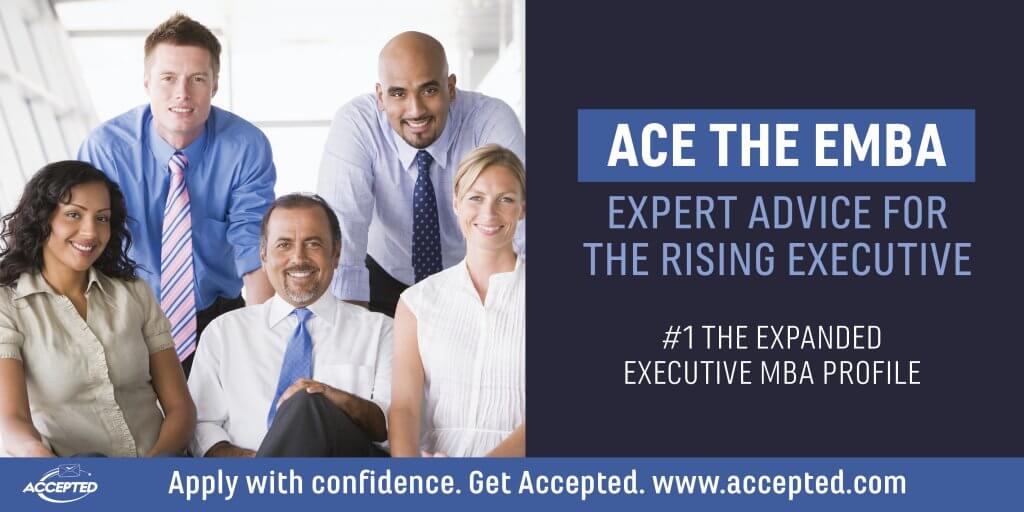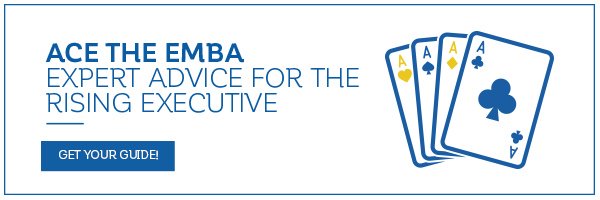

This is the first post in our Ace the EMBA series on how to apply successfully to a top executive MBA program.
The Executive MBA profile has changed over the past decade. Allen, a hypothetical candidate described below, represents the traditional EMBA candidate, which is still highly desirable to EMBA programs. Lucia, another hypothetical candidate, also described below, represents a profile that is not uncommon now, as does hypothetical Kareem. Most important, no longer does Allen reflect the “choice” candidate. Today’s EMBA programs actively seek a wide range of applicants – not just diverse geographic, functional, and industry backgrounds, but also diverse organizational cultures and career pathways (e.g.: Serial entrepreneur? Engaged in public-private partnerships? From industry to consulting or vice versa?). The remaining common denominator is extensive management experience and/or imminent advancement into senior management. Even the meaning of “management experience” may vary now – for example, in matrix organizations and project-oriented careers, the conventional “direct report” concept may be irrelevant.
1. At thirty-five years old, Allen has worked professionally for thirteen years, the last eight as a marketing manager in increasingly strategic positions. He is now Director of Marketing and Strategy for his Fortune 1000 company’s new product line. His record of advancement is impressive for someone in his industry, pharmaceuticals, where people of his age are usually a few rungs lower and where some of his peers have MBAs. Allen’s next move will be to a senior management role, and he feels that without a sophisticated management skill set, he will be unable to contribute to his maximum ability as an executive. Knowing that this skill set is exactly what EMBA programs are created to provide, he discusses pursuing an EMBA with his boss. Allen’s company, eager to retain him and groom him for a senior position, will sponsor the time requirement of his Executive MBA studies, and one-third of the cost.
2. After working for a year after college as a technology consultant, Lucia started consulting independently. Initially she provided IT guidance to her local school district as part of a community volunteer program. During this initiative she realized that the public education sector offered unique opportunities as well as challenges in mastering the complex bureaucratic, budgeting, and political maze, and she decided to develop a part-time independent business providing IT consulting to the public education sector, on top of her “day job.” It turned out to be a lucrative and interesting niche, and within one more year, Lucia had enough business to leave her employer and set up her own consulting business full time. Eight years later, she has seven employees, grosses over $12M in sales annually, and has broadened her service to private schools. At this level, she can barely manage the business. To grow further, Lucia needs to streamline and stabilize her organizational infrastructure while developing a solid five-year growth strategy. She is more than willing to pay for her EMBA at a top program, viewing it as a necessary investment for growth.
3. Kareem has been an architect of some of the top products at a global technology firm. He has led numerous high-profile project teams and interacted with senior technologists and executives at Fortune 100 customers – even participated in some key product decisions. Increasingly he has felt that becoming a senior manager would allow him to best utilize the combined market and technology know-how he has accrued, and his employer and does not want to lose one of its stars. Hence, the company has agreed that Kareem will transition to the business side to manage a new product line he has championed, a role that will include P&L responsibility. Kareem decides to pursue an EMBA as the best way to prepare for his imminent senior management role. He will pay the tuition, and his company will accommodate the schedule.
These three candidates now face the challenge of applying to EMBA programs. First, they must select the programs they want to target from an increasingly large and multifaceted selection. Then, although they are all strong applicants, they still must distinguish themselves through their application essays. In this series, we will explore the changing EMBA options and how to choose among them, and then address the roll-up-the-shirtsleeves part of the process: developing effective essays.
Do you need help applying to your target Executive MBA programs, efficiently and successfully? Work one-on-one with an EMBA admissions expert for comprehensive application assistance. It’s time to get you ACCEPTED! View our EMBA services here.
Related Resources:
• Top Executive MBA Essay Questions: How to Answer Them Right, a free guide
• Excellent Executive MBA Admissions Advice, a podcast episode
• The MBA Family Tree: A Roundup & Overview of Different MBA/EMBA Options
The post Ace the EMBA: Expert Advice for the Rising Executive #1 The Expanded Executive MBA Profile appeared first on Accepted Admissions Blog.


No comments:
Post a Comment